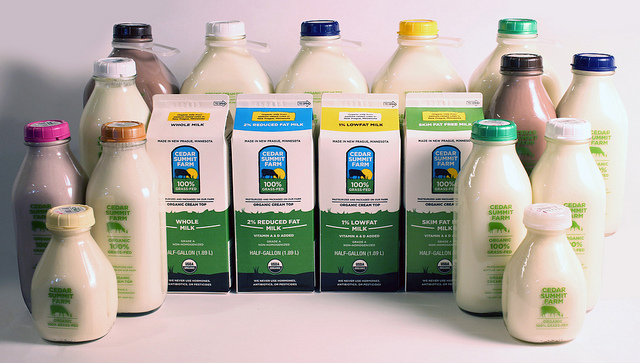Are Grass-Fed Products Really Healthier?

Organic foods can be found in almost every supermarket now a days. Organic dairy, poultry and beef are becoming readily available as consumers are more aware of the importance or “real” food. This is a step in the right direction, but I think it’s important to consider grass-fed animals. The nutritional value of grass-fed animal products far exceeds that of even organic animal products.
The limitations of the organic label is most apparent with animal
products. The label does not mean it has the most nutritional content.
When I purchase yogurt, butter and especially meat I look for a label
saying the product is produced from “grass fed” animals rather than the
organic label.
Let’s compare, for example, organic animal meat to grass-fed meat.
Organic meat comes from animals that are fed grains. It doesn’t matter if it’s ordinary grain, organic or even GMO grains, the meats’ nutritional value will be lacking. Grain fed animals have a third less omega-3 fatty acid, a fourth less Vitamin E, an eighth less beta-carotene and barely have any amount of CLA, (a cancer fighting fat) than meat from animals that were grass fed.
Grains also make the digestive track highly acidic, causing E.coli to grow rapidly and become more resistant to acid. According to the recently published study in the journal Science, this super E.coli bacteria is able to survive our bodies cleaning acidity of our digestive juice and will make us sick.
We need to be aware of what our food is being fed. Do you remember hearing about Mad cow disease? It is suspected to be from cattle being fed the trimmings from other processed cattle. Cows are naturally herbivores, and until 1997 they were being fed a diet that turned them into cannibal carnivores. I’m not interested in eating any product that isn’t fed or grown as nature intended.
Health Benefits of Grass Fed Products
Grass fed beef is loaded with beta-carotene, Vitamins C and E and has 5 times the amount of CLS (conjugated linoleic acid) as grain-fed animals and has the perfect balance of polyunsaturated fats.
Beta-carotene: A powerful antioxidant that also limits damage to the cell membrane, DNA and our bodies tissue protein structure. Enzymes in our intestinal wall convert beta-carotene to Vitamin A which promotes a healthy visual cycle, reproductive production and maintains epithelial functions, growth and production.
Vitamin C: An antioxidant that also lowers blood pressure and lowers blood lead levels, promotes healthy eye function, boost our immune system and acts as a natural antihistamine.
Vitamin E: Also an antioxidant that protects cell damage and is key for healthy skin, eyes and a strong immune system.
CLA: (conjugated linoleic acid) may be the strongest
cancer fighting fat we have in our diet. In lab animals, even the small
amount of 5% of CLA in their diet has reduced tumors by 50%. It also
reduces the risk of diabetes, obesity and many immune diseases.
Our bodies need polyunsaturated (“good”) fat such as omega 6 and omega
3.
Omega 6: Regulates blood pressure, blood clotting, inflammation, immunity and brain function.
Omega 3: Reduces the risk of heart disease, high blood pressure, cancer, arthritis, autoimmune and inflammatory disorders.
These fats make up our cell membrane walls. When humans have too much though, they tend to have more health problems. Scientist have found a ratio exceeding 4:1 (omega 6 : omega 3) to be too much for our bodies to function properly.
North Dakota State University studies ratios of omega 6 and omega 3
in grass-fed and grain-fed bison. They found that grass-fed bison have a
ratio of 4:1. Grain-fed bison have a ratio of 20:1 (omega 6 : omega 3).
These ratios become further imbalanced the longer the animal is fed a
grain diet.
Grass-fed animals meat is naturally leaner with 7% of its total fat content being omega 3 compared to grain-fed only containing 1%. They are not fattened with grains, soy or corn and have the ideal ratio of omega 6 and omega 3. Grass-fed animal meat offers antioxidants, vitamins, cancer fighting fats and a perfect balance of the healthy fats, omega 6 and omega 3 with a ratio of 3:1.
Most grass-fed farmers operate close to the requirements of the organic restrictions. They avoid herbicides, pesticides, antibiotics and growth hormones. Grass-fed animals are raised on their native diets, left to forge in open pastures, living a low-stress life growing at their natural pace. This create a healthy animal that provides meat that is nutritious and beneficial to our bodies.
Source(s):
http://livingtraditionally.com/